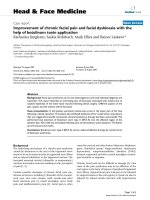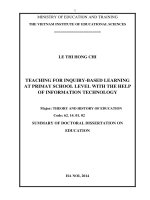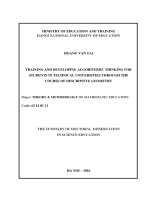skkn MOTIVATING STUDENTS IN ENGLISH CLASS WITH THE HELP OF ENGLISH SHORT CLIPS
Bạn đang xem bản rút gọn của tài liệu. Xem và tải ngay bản đầy đủ của tài liệu tại đây (653.4 KB, 14 trang )
SỞ GIÁO DỤC VÀ ĐÀO TẠO ĐỒNG NAI
TRƯỜNG THPT CHUYÊN LƯƠNG THẾ VINH
Mã số: ................................
------
SÁNG KIẾN KINH NGHIỆM
MOTIVATING STUDENTS IN ENGLISH CLASS
WITH THE HELP OF ENGLISH SHORT CLIPS
Người thực hiện: PHAN THỊ NHƯ ANH
Lĩnh vực nghiên cứu: Phương pháp dạy học bộ môn tiếng Anh
Sản phẩm đính kèm:
Mô hình
Phần mềm
Phim ảnh
Hiện vật khác
--------------------Năm học 2016- 2017
1
SƠ LƯỢC LÝ LỊCH KHOA HỌC
-----I. THÔNG TIN CHUNG VỀ CÁ NHÂN
1. Họ và tên: PHAN THỊ NHƯ ANH
2. Ngày tháng năm sinh: 07- 09 - 1982
3. Giới tính : Nữ
4. Địa chỉ: 100/1c Hà Huy Giáp, P. Quyết Thắng, TP. Biên Hòa, T. Đồng Nai
5. Điện thoại: 0918539309
6. E-mail:
7. Chức vụ: Giáo viên giảng dạy bộ môn tiếng Anh
8. Đơn vị công tác: Trường THPT chuyên Lương Thế Vinh
II. TRÌNH ĐỘ ĐÀO TẠO
- Học vị (hoặc trình độ chuyên môn, nghiệp vụ) cao nhất: Thạc sĩ
- Năm nhận bằng: 2011
- Chuyên ngành đào tạo: Ngôn Ngữ Ứng Dụng
III. KINH NGHIỆM KHOA HỌC
- Số năm có kinh nghiệm trong lĩnh vực chuyên môn: 9 năm
- Các sáng kiến kinh nghiệm đã có trong 5 năm gần đây: Không có.
2
CONTENTS
I. INTRODUCTION
II. RESEARCH QUESTION
III. IMPLEMENTATION
IV. LITERATURE REVIEW, FINDINGS AND INTERPRETATION
V. CONCLUSION
3
I. INTRODUCTION
As a teacher of Luong The Vinh High School for the Gifted and having taught different
classes for the past few years, I can’t help but noticing that the majority of the students of
the school just focus on their major subjects. This means only students of English classes
really have strong motivation to study English while those in other classes such as Math,
Physics, Biology or Literature, etc…lack motivation as well as interest in learning the
subject. There are many reasons accounting for this, but one of them can be narrowed
down to the fact that they don’t find the lessons interesting enough. From my own
observation, the students get fed up with the amount of excessive grammar in each unit.
Furthermore, although there have been revisions and updating, the lessons in their course
books, somehow, lack authenticity, or in other words, fail to stimulate them. Having
identified the problem, I have tried showing some English clips in my classes. The result
is quite promising- the students did show more enthusiasm and excitement in engaging in
the lessons.
II. RESEARCH QUESTION
This mini paper aims to clarify the following identified issue among students of Luong
The Vinh High School for The Gifted:
- The possibility of using English clips in the classroom as an effective way to
motivate students in English class.
III. IMPLEMENTATION
Step 1. Define the theme/main topic of each lesson in the course book.
For example: Unit 9 in English 10 is “Undersea World”. Therefore, teachers may search
for clips with key words such as: “marine life”, “undersea creatures”, “interesting sea
creatures”, etc…
Step 2. Search for appropriate clips.
4
By “appropriate” I mean the teacher should search for a clip that has a similar content
with the topic of the lesson. In addition, the language used in the clip should not be too
hard for the students’ input. Another important thing to be taken into consideration when
searching for a clip to show in class is that the teacher is expected to make sure there is
no offensive “language” or anything inappropriate for Vietnamese high school students.
Step 3. Show clips
Once the teacher has found the appropriate clip to show in front of the class, he or she
should decide the right time to do this- whether before the lesson as a warm-up activity,
in the middle of the lesson as a listening task, or as a sum-up activity at the end of each
unit. This depends as whether the teacher wants to use the clip as a catchy introduction to
a new lesson, as a part clarifying an important point in a lesson, or as a wrap-up for a
lesson.
In addition, since it’s a known fact that the allocated time for each unit in the textbook is a
pressure for both teachers and students, it should be up to the teacher in charge to decide
when and how to include video clips in her/his teaching.
Here is an example of one of the lessons I teach using clips as visual aids:
ENGLISH 10.
UNIT 4: SPECIAL EDUCATION
A Tap Dancer Who Proves Anything Is Possible.mp4
/>Before showing the clip to the class, the teacher writes a few questions on the board:
1. What is special about this dancer?
2. How old was he when he started tap dancing?
3. How old was he when he figured a problem with a part of his body?
4. What was actually the problem?
5. How many surgeries did he have totally?
6. What do we learn from this dancer?
5
After showing the clip for the first time, the teacher write some key new words on the
board to help the students understand the clip better.
New words:
- tumor (n)
- amputate (v)
- chemo (n) = chemotherapy
After the students have understood the clip and are able to answer all the given questions,
the teacher can lead in the topic of the unit which is teaching children with special needs:
SPECIAL EDUCATION
IV. LITERATURE REVIEW, FINDINGS AND INTERPRETATION
The recent years have witnessed a shift in English teaching approaches. To be more
specific, it has been clearly stated by the Ministry of Education that English teachers
should now pay more attention to communicative skills when teaching English as a
compulsory subject in schools. For the past few years speaking and listening skills have
been put into official assessment scale for 10 th graders nationwide. At Luong The Vinh
High School, 10 graders and 11 graders have oral final exams together with paper-based
exams which include listening tasks. Therefore, I believe it is high time English teachers
put more emphasis on bringing more listening and speaking tasks into the classroom. One
of the most possible and effective ways, in my own opinion, is to introduce English clips
to our students.
First, I’d like to point out the advantages of using English clips as teaching material in the
classroom. There is one thing that we can be sure, and that is these clips are “those which
have been produced for purposes other than to teach language" (Nunan 1988, p. 99). As
for me, I usually download short clips from some talk shows hosted by famous people
such as Ellen DeGeneres, or sometimes short inspirational clips for some advertising
campaigns. The point is these clips, since not made for the purpose of teaching, are
“authentic”, and are therefore, “natural” in terms of real life and meaningful
communication (Rogers, 1988). When it comes to the benefits of using authentic materials
in the classroom, according to Philip, Shettlesworth, and Clarke (as cited in Richards,
6
2001), there are a few that are worth considering: “they [authentic materials] have a
positive effect on learner motivation, provide authentic cultural information and exposure
to real language, relate more closely to learners ' needs, and support a more creative
approach to teaching”. In short, what I’ve been trying to prove is that the English clips I
use in my classroom, as authentic materials, are really helpful in my teaching.
I have been showing several clips for my students in different classes and their feedbacks
are, to a certain extent, positive. The students all agree that with the audio and visual
effects, these clips can instantly grab their attention. In addition, to make sure that
students are engaged in the activity, I try to choose clips of interviews with celebrities or
about popular issues everyone knows of (see attached clips for reference). One good point
about this new material is that although the students don’t always understand all the words
and phrases, they still can have a general idea of what the whole clip is about. And this is
of no doubt very close to the well-known communicative approach. As a result, all of the
students show great enthusiasm and engagement. Even for those who admit that they can’t
understand the whole content of a clip express their eagerness for more clips. Besides that,
I’d like to emphasize that “positive attitudes towards the self, the native language group,
and the target language group enhanced proficiency” (Brown, 2000). When students sit in
the classroom, ready for a new lesson or task with positive attitudes, they are likely to
experience success, or at least, to produce better performance of their language ability.
So as to illustrate the points I made above, I’d like to enclose here the result of a survey I
conducted among 100 random students I was teaching last year. The questionnaire
consisted of 8 different questions asking for their opinions about the importance of
Speaking and Listening skills as well as about the English clips I showed to them.
Statement
Strongly
Disagree
Neither
Disagree
(2)
Agree nor (4)
Agree
Disagree
(5)
(1)
Agree
Strongly
(3)
7
1.
Speaking
and 82
10
8
71
20
1
18
82
15
85
10
6
89
11
45
40
Listening are not as
important as Grammar
2.
Speaking
Listening
and 8
skills
are
difficult to improve.
3. I wish that I could
speak
fluent
and
accurate English.
4. I wish that the teacher
could
give
more
speaking and listening
tasks in class.
5.
English
speaking 70
14
clips shown in class are
too difficult for me to
understand.
6. I enjoy watching
English speaking clips.
7.
clips
English
are
speaking 22
helpful
78
in
improving my listening
and speaking skills.
8. Other than improving
15
speaking and listening
skills, English clips give
8
a lot of useful and
interesting information.
Drawbacks:
Nevertheless, it is undeniable that teachers are likely to experience difficulties of using
English clips as teaching materials. In terms of outside factors, first and foremost, not all
classrooms are equipped with suitable devices for showing clips. As the case of my
school, we have to register the media room in advance whenever we need to use the
projector. This could be a problem if other teachers also need the media room for their
classes on the same date as we choose. Also, the fact that students have to move around
from their own class to the media room and then back to their classroom for the next
subject may take some time off their time for the lesson.
Secondly, as I earlier mentioned, it may be time-consuming for the teacher to choose a
suitable clip to show to the students. Searching for a clip that suits the content of a unit in
the course book, or one with enough entertaining factors but without exceeding the limit
of Asian culture’s norm, or one with interesting message but still within students’ English
ability…takes a lot of time. Given that a teacher has already a great deal of work to do and
a number of different classes to teach, this may be an unreasonable request to make. That
is not to say even when the teacher is willing to go all the way to find the best clips for his
or her students, he or she has another obstacle to deal with: the restricted time for each
unit. It’s a known fact that standardized English tests still put a lot of emphasis on
grammar and structures, meaning that the teacher has to make sure the students master all
grammar points with enough exercises to practice. This leaves little time for activities to
improve speaking and listening skills.
In terms of subjective difficulties, although in the same class, students have various levels
of English competence. This is definitely something to take into consideration when
choosing a clip and showing it in class. Sometimes, even with the “right” clip, the teacher
should be thoughtful and flexible enough when it comes to using it as a teaching aid. On
9
saying this, I mean the teacher may need to pause a clip several times to help with some
vocabulary, or to make questions to make sure that all students understand what is going
on. Definitely, a good teacher should never leave any student feeling lost in this additional
activity.
V. CONCLUSION
Scarcella (1990) said that “cognitive and interactional patterns” which means “learning
style” can affect the ways students “perceive, remember, and think”. Scarcella also said
that if teachers don’t take into consideration their students’ learning styles to choose
compatible ways in their teaching, their students may have to “suffer the consequences”.
Being well aware of this, teachers all over the world have been trying to put more effort in
choosing suitable approaches and teaching styles to help their students achieve the best
results out of school. Each and every approach and technique has their own effects and
drawbacks; therefore, it’s considered a teacher’s responsibility to continue offering more
choices for his or her students. Using English short clips in classroom as a way to
motivate students may not always work for all students or for all classes, however; it’s
worth a try.
10
REFERENCE
Brown, H. D. 2000. Principles of language learning and teaching. 4th ed. White Plains,
NY: Addison Wesley Longman.
Nunan D. (1988). The learner-centered curriculum. Cambridge: Cambridge University
Press.
Richard, J.C. (2001). Curriculum development in language teaching. Cambridge:
Cambridge University Press.
Scarcella, R. (1990) Teaching language minority students in the multicultural classroom:
Prentice Hall Regents
/>
11
SỞ GD&ĐT ĐỒNG NAI
CỘNG HOÀ XÃ HỘI CHỦ NGHĨA VIỆT NAM
Đơn vị: Trường THPT Chuyên
Độc lập - Tự do - Hạnh phúc
Lương Thế Vinh
––––––––––––––––––––––––
–––––––––––
Biên Hòa, ngày 18 tháng 05 năm 2017
PHIẾU ĐÁNH GIÁ, CHẤM ĐIỂM, XẾP LOẠI SÁNG KIẾN KINH NGHIỆM
Năm học: 2016 -2017
–––––––––––––––––
Tên sáng kiến kinh nghiệm: MOTIVATING STUDENTS IN ENGLISH CLASS WITH THE HELP OF
ENGLISH SHORT CLIPS
Họ và tên tác giả: Phan Thị Như Anh
Chức vụ: .............................................
Đơn vị: Trường THPT Chuyên Lương Thế Vinh
Họ và tên giám khảo 1: ............................................................ Chức vụ: ......................................
Đơn vị: ...........................................................................................................................................
Số điện thoại của giám khảo: .........................................................................................................
* Nhận xét, đánh giá, cho điểm và xếp loại sáng kiến kinh nghiệm:
1. Tính mới
.........................................................................................................................................................
.........................................................................................................................................................
.........................................................................................................................................................
Điểm: …………./6,0.
2. Hiệu quả
.........................................................................................................................................................
.........................................................................................................................................................
.........................................................................................................................................................
Điểm: …………./8,0.
3. Khả năng áp dụng
.........................................................................................................................................................
.........................................................................................................................................................
.........................................................................................................................................................
Điểm: …………./6,0.
Nhận xét khác (nếu có): ..................................................................................................
Tổng số điểm ....................../20. Xếp loại: ..................................................................
GIÁM KHẢO 1
12
SỞ GD&ĐT ĐỒNG NAI
CỘNG HOÀ XÃ HỘI CHỦ NGHĨA VIỆT NAM
Đơn vị: Trường THPT Chuyên
Độc lập - Tự do - Hạnh phúc
Lương Thế Vinh
––––––––––––––––––––––––
–––––––––––
Biên Hòa, ngày 18 tháng 05 năm 2017
PHIẾU ĐÁNH GIÁ, CHẤM ĐIỂM, XẾP LOẠI SÁNG KIẾN KINH NGHIỆM
Năm học: 2016 -2017
–––––––––––––––––
Tên sáng kiến kinh nghiệm: MOTIVATING STUDENTS IN ENGLISH CLASS WITH THE HELP OF
ENGLISH SHORT CLIPS
Họ và tên tác giả: Phan Thị Như Anh
Chức vụ: .............................................
Đơn vị: Trường THPT Chuyên Lương Thế Vinh
Họ và tên giám khảo 2: .......................................................... Chức vụ: ........................................
Đơn vị: .........................................................................................................................................
Số điện thoại của giám khảo: ........................................................................................................
* Nhận xét, đánh giá, cho điểm và xếp loại sáng kiến kinh nghiệm:
1. Tính mới
.........................................................................................................................................................
.........................................................................................................................................................
Điểm: …………./6,0.
2. Hiệu quả
.........................................................................................................................................................
.........................................................................................................................................................
.........................................................................................................................................................
Điểm: …………./8,0.
3. Khả năng áp dụng
.........................................................................................................................................................
.........................................................................................................................................................
.........................................................................................................................................................
Điểm: …………./6,0.
Nhận xét khác (nếu có): ....................................................................................................
.........................................................................................................................................................
Tổng số điểm: .............../20.
Xếp loại: ................................................................
GIÁM KHẢO 2
13
SỞ GD&ĐT ĐỒNG NAI
Đơn vị: Trường THPT Chuyên
Lương Thế Vinh
–––––––––––
CỘNG HOÀ XÃ HỘI CHỦ NGHĨA VIỆT NAM
Độc lập - Tự do - Hạnh phúc
––––––––––––––––––––––––
Biên Hòa, ngày 18 tháng 05 năm 2017
PHIẾU NHẬN XÉT, ĐÁNH GIÁ SÁNG KIẾN KINH NGHIỆM
Năm học: 2016 -2017
–––––––––––––––––
Tên sáng kiến kinh nghiệm: MOTIVATING STUDENTS IN ENGLISH CLASS WITH THE HELP OF
ENGLISH SHORT CLIPS
Họ và tên tác giả: Phan Thị Như Anh
Chức vụ: .............................................
Đơn vị: Trường THPT Chuyên Lương Thế Vinh
Lĩnh vực: (Đánh dấu X vào các ô tương ứng, ghi rõ tên bộ môn hoặc lĩnh vực khác)
- Quản lý giáo dục
- Phương pháp dạy học bộ môn: ...............................
- Phương pháp giáo dục
- Lĩnh vực khác: ........................................................
Sáng kiến kinh nghiệm đã được triển khai áp dụng: Tại đơn vị
Trong Ngành
1. Tính mới (Đánh dấu X vào 1 trong 3 ô dưới đây)
- Đề ra giải pháp thay thế hoàn toàn mới, bảo đảm tính khoa học, đúng đắn
- Đề ra giải pháp thay thế một phần giải pháp đã có, bảo đảm tính khoa học, đúng đắn
- Giải pháp mới gần đây đã áp dụng ở đơn vị khác nhưng chưa từng áp dụng ở đơn vị mình, nay
tác giả tổ chức thực hiện và có hiệu quả cho đơn vị
2. Hiệu quả (Đánh dấu X vào 1 trong 5 ô dưới đây)
- Giải pháp thay thế hoàn toàn mới, đã được thực hiện trong toàn ngành có hiệu quả cao
- Giải pháp thay thế một phần giải pháp đã có, đã được thực hiện trong toàn ngành có hiệu quả
cao
- Giải pháp thay thế hoàn toàn mới, đã được thực hiện tại đơn vị có hiệu quả cao
- Giải pháp thay thế một phần giải pháp đã có, đã được thực hiện tại đơn vị có hiệu quả
- Giải pháp mới gần đây đã áp dụng ở đơn vị khác nhưng chưa từng áp dụng ở đơn vị mình, nay
tác giả tổ chức thực hiện và có hiệu quả cho đơn vị
3. Khả năng áp dụng (Đánh dấu X vào 1 trong 3 ô mỗi dòng dưới đây)
- Cung cấp được các luận cứ khoa học cho việc hoạch định đường lối, chính sách:
Trong Tổ/Phòng/Ban Trong cơ quan, đơn vị, cơ sở GD&ĐT
Trong ngành
- Đưa ra các giải pháp khuyến nghị có khả năng ứng dụng thực tiễn, dễ thực hiện và dễ đi vào cuộc sống:
Trong Tổ/Phòng/Ban
Trong cơ quan, đơn vị, cơ sở GD&ĐT Trong ngành
- Đã được áp dụng trong thực tế đạt hiệu quả hoặc có khả năng áp dụng đạt hiệu quả trong phạm vi rộng:
Trong Tổ/Phòng/Ban
Trong cơ quan, đơn vị, cơ sở GD&ĐT Trong ngành
Xếp loại chung: Xuất sắc
Khá
Đạt
Không xếp loại
Cá nhân viết sáng kiến kinh nghiệm cam kết không sao chép tài liệu của người khác hoặc sao
chép lại nội dung sáng kiến kinh nghiệm cũ của mình.
Tổ trưởng và Thủ trưởng đơn vị xác nhận sáng kiến kinh nghiệm này đã được tổ chức thực hiện
tại đơn vị, được Hội đồng khoa học, sáng kiến đơn vị xem xét, đánh giá, cho điểm, xếp loại theo quy
định.
NGƯỜI THỰC HIỆN SKKN
XÁC NHẬN CỦA TỔ
CHUYÊN MÔN
THỦ TRƯỞNG ĐƠN VỊ
14









